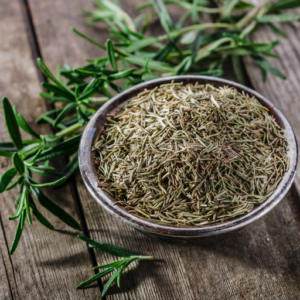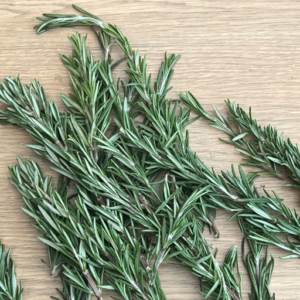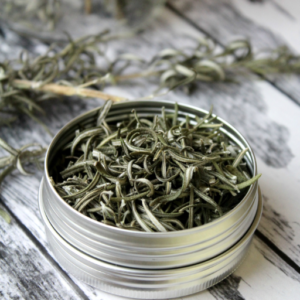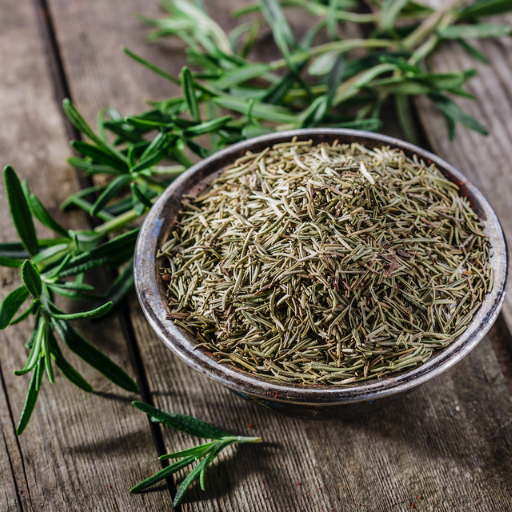To capture rosemary’s lively taste and smell, learning how to dry and store this herb properly is crucial. Rosemary has a strong flavor that is used in many different ways in cooking. But if you don’t handle it correctly, its freshness will disappear quickly. This article will discuss different methods for drying rosemary, including air-drying like they used to do or using new technology appliances. We’ll also give helpful tips on keeping your dried rosemary so that it stays good and potent, allowing you always to enjoy adding this flavorful herb into your meals throughout the year! If you are an experienced chef or someone who loves plants, mastering the process of drying out some sprigs of deliciously scented rosemaries can improve your recipes and make cooking more fun!
What Are the Best Ways to Dry Rosemary?

Image source: https://www.masterclass.com/
There are lots of great ways to dry peppermint, depending on what works well for each individual’s preferences.
- Air Drying: For a simple but traditional method, grab some stems from a bunch of rosemary and tie them together in small clusters before hanging them upside down somewhere cool/dry/well-ventilated where sunlight won’t directly hit them. It usually takes one to two weeks to fully dehydrate.
- Oven Drying: If you’re looking for something faster, spread out the pieces evenly across a baking sheet. Then, put them into an oven set at its lowest possible temperature (with the door cracked open slightly so moisture can escape), checking every thirty minutes or so until crispy leaves form.
- Dehydrator: The food dehydrator is considered one of the most effective techniques for drying herbs. What you need to do here is place rosemary onto trays within the device and let it stand under conditions around 95°F – 115 °F (35°C -46°C). This method typically takes several hours, but check regularly if things speed up too quickly!
- Microwave Drying: If you want to dry some herbs really fast, take a few sprigs of rosemary, sandwich them between two paper towels, and zap them in the microwave for 20-30 seconds until they become crumbly.
The best method for each person depends on their schedule and what works best for them; however, no matter which technique is chosen, make sure all moisture has been removed from these twigs; otherwise, mold could develop during storage periods later down the road.
How to Air Dry Rosemary
Here’s how you can successfully air-dry rosemary:
- Harvesting: In the morning, pick healthy rosemary sprigs after the dew has dried. Cut just above a leaf node to encourage new growth.
- Preparation: Remove damaged or yellow leaves and wash the sprigs gently to remove dust. Dry them with a towel to eliminate excess moisture.
- Bundling: Use twine or string to tie small bundles of rosemary sprigs together. This looks good and allows for proper air circulation, too.
- Hanging: Hang upside-down bunches of herbs in a cool, dark, well-ventilated place. Ideally, this should be a low-humidity area, which will help with the drying process.
- Drying Time: Let rosemary air-dry for 1-2 weeks. You’ll know when it is ready as the leaves will feel brittle.
-
Storage: Remove dried leaves from stems and store them in an airtight container away from light and heat so that they stay flavorful longer.
Following these steps will let you effectively air dry rosemary while retaining its aromatic properties, ensuring you have dried herbs available for cooking all year round.
Using a Dehydrator to Dry Rosemary
A dehydrator is one of the quickest and most effective ways to dry rosemary while ensuring it retains its intense flavor. The following steps outline the best way to do this:
- Preparation: Take fresh, undamaged, pest-free rosemary sprigs and rinse them with cold water before patting them dry with a paper towel.
- Arranging: If desired, strip the leaves from the stems and spread them in a single layer on dehydrator trays. Do not overcrowd, as it prevents proper air circulation.
- Drying Settings: For herbs like rosemary, your food dehydrator should be set to 95°F –115°F (35°C–46°C).
- Drying Time: Leave your rosemary in for 2-4 hours, checking every so often; when done, it will be crisp enough to crumble easily.
- Storage: Cool completely, then place in an airtight container. Store away from light or heat sources for maximum freshness.
Dehydrators are more efficient than air drying because you have higher-quality dried herbs ready for cooking.
How Do You Dry Rosemary in the Oven?
The oven-drying process for rosemary is straightforward and gives aromatic results. Here is a quick guide on the best methods:
- Preparation: Preheat the oven to low heat, ideally between 170°F and 200°F (77°C to 93°C). Choose fresh and clean rosemary sprigs and remove any damaged leaves.
- Arranging: Place the rosemary in one layer on a baking sheet lined with parchment paper. Space out the leaves for even drying.
- Drying process: Put the baking sheet into the preheated oven. To help dry, leave the oven door slightly open so that moisture can escape. Check on it every 10-15 minutes and turn if needed.
- Time: The usual drying time is 30-60 minutes, depending on how wet the fruit is when picked. It should be brittle and crumble easily when touched.
- Storage: Cool before moving into an airtight container, then store in a cool, dark place away from sunlight, which helps retain flavor longer.
This method allows you to quickly dry rosemary while keeping its fragrance intact, making it easier to use in cooking or other recipes requiring dried herbs, such as tea blends.
How to Harvest Rosemary for Drying?

Drying rosemary is easy and can be done with limited techniques if the right quality is ensured. The first step should be selecting mature and healthy plants at least six inches tall. This herb should preferably be harvested in the morning after dew has dried up since this is when its oils are most concentrated. Use sharp, clean scissors or pruning shears to cut sprigs from the plant, ideally 4-6 inches long, from near the top of the stem. Do not take more than a third of any one plant so that it can regrow later on. Rinse gently under cool running water to remove dirt and pests after harvesting, then pat dry with a towel before use or storage. This method will allow you to gather dry rosemary while promoting healthy growth.
When Is the Best Time to Harvest Fresh Rosemary?
Typically, fresh rosemary is best harvested early in the morning before heat sets in, but after dew evaporates during summer, days get hot quickly after sunrise until sunset. At this point essential oils are still concentrated which enhances flavor upon cooking food with added herbs/seasonings used for seasoning meats/fish dishes etc.. Just before flowering is recommended because leaves have the strongest taste just before the flowering stage; constant pruning throughout the growing season encourages bushier growth & healthier plants overall, leading towards higher yields during peak harvest seasons every year due to increased density per square foot area planted out over periods longer than one season.
How to Properly Prepare Rosemary Sprigs
Here are some concise steps to clean and prepare rosemary sprigs for use or drying according to the latest expert advice:
- Wash the Sprigs: Run cold water over the rosemary sprigs, then rinse them. Gently pat them dry with a clean towel.
- Remove Leaves: Hold the top of the sprig and slowly pull downwards to remove the leaves from the stem. Discard any woody stems and brown or damaged leaves while keeping only healthy green ones.
- Chop As Desired: Depending on how you plan to use it, chop rosemary leaves into your preferred size. Finely chopped rosemary gives more flavor, whereas larger pieces can be used for garnishing.
- Storage: If not using right away, refrigerate in an airtight container for up to one week; otherwise, freeze for longer preservation. Alternatively, dried rosemary may be stored in a cool, dark place for up to one year.
These steps will help meet your culinary needs with well-prepared yet fresh-tasting flavorful herbs like rosemary.
How Do You Use a Dehydrator to Dry Rosemary?

The process of drying rosemary with a dehydrator is simple enough. First, wash and prepare the rosemary sprigs described above before removing their leaves and chopping them if desired. Next, evenly spread them out on trays of dehydrator such that they don’t overcrowd each other, which promotes equal drying, then set the temperature between 95°F -115°F (35°C-46°C) for best results usually take around two-four hours, but make sure you often check since it can vary depending on many factors such as humidity level, when done herbs should crumble easily between fingers after which store them carefully away from light inside airtight containers so that aroma does not escape easily.
Step-by-Step Guide to Dehydrate Rosemary
- Choose Fresh Rosemary: Look for healthy, bright sprigs of rosemary. Pick stems that have no marks or signs of wilting.
- Wash and Dry: Rinse the rosemary under cool water to remove dirt or pesticides. Use a clean towel to pat the sprigs dry, or let them air dry to remove moisture.
- Trim and Prepare: If you want, remove the leaves from the woody stems. You can keep the sprigs whole or break them into smaller pieces to make storage easier.
- Arrange on Trays: Place the rosemary in a single layer on dehydrator trays or baking sheets if using an oven. Make sure there is space between each sprig for air circulation.
- Set Temperature: For a dehydrator, set it between 95°F (35°C) and 115°F (46°C). Set your oven to its lowest temperature—ideally around 180°F (82°C)—and leave it slightly ajar so moisture can escape.
- Dehydrate: Check every hour after the rosemary has dried for one hour but up to four hours total; when done correctly, leaves should feel crispy and dry beneath fingers upon touch.
- Cool and Store: Wait until completely cool before placing in an airtight container; store somewhere dark and cool, as this will help maintain flavor and aroma longer than other methods would allow for cooking purposes only!
Use this brief guide to dehydrate rosemary while retaining essential oils & strong taste through culinary uses.
How Long Does It Take to Dehydrate Rosemary?
The duration of the rosemary dehydration process varies according to its method. Typically, a dehydrator takes between 1 and 4 hours at temperatures ranging from 95°F (35°C) to 115°F (46°C). Alternatively, an oven can take about 1-3 hours on low heat, around 180°F (82°C), with the door slightly open to allow moisture escape. Check for doneness by ensuring leaves are dry and crumbly since over-drying may lead to loss of flavor and aroma.
Signs That Rosemary Is Done Drying
There are several signs you can look for when determining if your rosemary is fully dried:
- Texture: When touched, leaves should feel crunchy and brittle. They should easily crumble under pressure between your fingers. More drying time is needed if they have a leathery or flexible texture.
- Color: The bright green color of fresh rosemary will slightly fade as it dries out. Finished dried rosemary will appear duller and darker in hue.
- Smell: Dried rosemary should be intensely aromatic. A faint scent indicates it might not be completely dried out yet and could mold during storage.
These indicators confirm that your herb has been properly dehydrated, allowing you to use it in cooking while retaining maximum flavor potency.
How to Store Dried Rosemary for Longevity?

Proper storage is vital if you want your dried rosemary’s taste and fragrance to last long enough for future use. It must be kept in an air-tight container like a glass jar or metal tin to keep moisture out completely. Ideally, store this away from direct sunlight exposure at cool places such as kitchen cupboards where heat cannot reach easily, but remember not too far inside either because humidity levels are high towards top areas near ceilings where warm air rises continuously throughout daylight hours causing condensation build up over time leading eventually rotting problems within weeks/months after opening package first time just once only! Date labeling helps track usage freshness better still. However, aim within six months ideally otherwise possible more extended periods up until year max allowed depending on how well maintained overall conditions were kept consistently throughout the entire lifetime span lengthwise hereafter forevermore henceforth thereafter onwards always eternally endless time infinity limitless boundaries without end whatsoever anywhere anytime anyplace anywhere else besides right here right now today tonight tomorrow next week month year decade century millennium on etcetera ad infinitum without stopping even once never again till kingdom come, praise God, hallelujah glory hallelujah amen amen amen.
Why and How to Store in an Airtight Container?
It is important to preserve dried rosemary’s flavor, smell, and strength. If you do not seal it well enough or store it in an airtight container, exposure to air will lead to oxidation that spoils quality, causing the loss of essential oils responsible for its distinctive aroma and taste. Such containers also prevent moisture absorption and pest invasion, which extends shelf life.
Storage-wise, use glass jars, metal tins, or other specially-made airtight storage vessels when dealing with dried rosemary. Before filling up a clean and completely dry container with the herb, ensure minimal space is left without rosemary, then close tightly afterward. You may consider adding desiccant packets to absorb any remaining wetness and further protect against spoilage of your spices. However, if possible, just keep these types away from direct sunlight exposure. Otherwise, it will degrade their color over time, making them less attractive visually, even more importantly than before, but still not enough to make someone want to eat something off it! Store this in cool, dark places like cupboards where no light gets through.
Ideal Storage Conditions for Dried Herbs
The best way to keep dried herbs good is by putting them away correctly. The best place for storing these items would be a cool, dark, dry zone such as under cabinets near sinks, where temperatures stay consistently low, around 60 degrees Fahrenheit or less, since warmer climates tend towards mold growth due to increased humidity levels which can occur quickly during summer months especially if windows aren’t opened regularly enough letting fresh air circulate throughout living spaces thereby preventing stale odors from developing due prolonged periods absence thereof but should also take care not overdo things either otherwise might end up creating sauna conditions inside our homes instead! Please remember that light damages plant material, so always use opaque containers whenever possible while keeping everything else out-of-sight behind closed doors, preferably located farthest away from any windowsills possible, given limited available square footage per household unit average size apartments rented out to college students attending classes full-time, year-round basis plus weekends holidays break vacations trips abroad etcetera ad infinitum until death do us part amen.
What Are the Ways to Use Dried Rosemary?

Dried rosemary is an ingredient that can be used in many different ways. It’s a great addition to marinades for meats, giving flavor and depth to chicken, lamb, and beef. You can also use it as a seasoning on roasted vegetables or potatoes or mix it into bread and pastry dough for added scent. Furthermore, you can infuse dried rosemary in olive oil or vinegar, making a fragrant base for dressings and dips. For something warm, try steeping some in hot water, like tea! Remember not to overdo the amount since its strong taste could overpower everything else.
Cooking with Dried Rosemary
When cooking with dried rosemary, knowing how to use its strong flavor in your dishes is important. First, crush the dried leaves between your fingers before adding them to a recipe; this releases essential oils and enhances the aroma. A good guideline is to use one teaspoon of dried rosemary for each tablespoon of fresh rosemary so you don’t overpower other flavors. Dried rosemary pairs well with roasted meats like chicken or lamb soups, stews, and marinades. Combine olive oil, garlic, and lemon juice, and marinate vegetables or meats in the mixture for something simple but delicious. The herb has many different flavors, which can be discovered through experimentation.
Herbal Remedies: How Can Dried Rosemary Be Used?
Dried rosemary adds flavor and provides health benefits when used medicinally. Traditionally, it has been used for digestion support, headache relief, and memory enhancement, among other things, such as making skin feel better after sun exposure due to its anti-inflammatory properties found within the plant itself! Infusing hot water with some leaves creates an excellent tea that helps clear respiratory passages while soothing upset tummies, too–an all-in-one, if you will! Also worth mentioning are studies showing diluted topical applications of essential oils derived from this particular type of herb (and possibly even diffusing them into open air) may help improve cognitive function/boost mood because who doesn’t want happier brains? Always check with your doctor first, though, in case there are any contraindications specific to YOU regarding using dried rosemaries medicinally since every individual’s body chemistry differs slightly.
Other Innovative Ways to Use Rosemary
Rosemary can be incorporated into various creative applications beyond traditional culinary uses. Here are some innovative ways to utilize this versatile herb:
- Herb-Infused Oils: Create rosemary-infused olive oil by steeping fresh rosemary sprigs in olive oil for a few weeks. This aromatic oil enhances salad dressings and can be drizzled over grilled vegetables or meats for added flavor.
- Scented Sachets: Dried rosemary can create fragrant sachets for closets and drawers. Combine it with lavender or cedar chips in a small cloth bag to keep clothes smelling fresh and deter moths.
- DIY Hair Rinse: A rosemary hair rinse can promote scalp health and stimulate hair growth. Steep dried rosemary in hot water, allow it to cool and use it as a final rinse after shampooing to add shine and vitality to your hair.
By experimenting with these innovative uses, you can fully appreciate rosemary’s versatility in both culinary and non-culinary applications.
Frequently Asked Questions (FAQs)
Q: What are the benefits of rosemary?
A: Rosemary is an evergreen herb that offers various benefits. It is packed with antioxidants, has anti-inflammatory properties, and may improve digestion and concentration. Additionally, dried rosemary can enhance flavor in various culinary dishes.
Q: How can I dry fresh rosemary?
A: There are several methods to dry fresh rosemary. You can dry rosemary in a dehydrator, air-dry it using an herb drying rack, or even use an oven or microwave. Rinsing and drying the rosemary thoroughly before any drying method is essential for the best results.
Q: How do I dry rosemary in a dehydrator?
A: Dry rosemary in a dehydrator by rinsing and drying the rosemary sprigs. Arrange the rosemary sprigs in a single layer on the dehydrator trays, ensuring enough air circulation. Set your food dehydrator to around 95-115°F and dry the rosemary for 6-8 hours until the leaves are dry and brittle.
Q: How long is the drying time for rosemary in a dehydrator?
A: The drying time for rosemary in a dehydrator typically ranges from 6-8 hours. However, the exact time may vary depending on the amount of rosemary you are drying and the specific settings of your dehydrator.
Q: Can I dry rosemary in the microwave?
A: Yes, you can dry rosemary in the microwave. Place a few rosemary sprigs between two paper towels and microwave on high for about 2-4 minutes, checking every 30 seconds until the leaves are dry and brittle.
Q: What are the steps to air-drying rosemary?
A: To air-dry rosemary, you can use an herb drying rack. First, rinse and pat dry the rosemary sprigs. Bundle them with string, and hang them upside down in a well-ventilated area out of direct sunlight. Allow them to dry for about 1-2 weeks until completely dry.
Q: How do I store rosemary after drying it?
A: Remove the rosemary leaves from the stems after ensuring that they are dry and brittle. Store the dried rosemary in an airtight container, such as a glass jar, in a cool, dark place. Properly stored rosemary can retain its flavor for up to a year.
Q: How do I know when the rosemary is completely dry?
A: You will know the rosemary is completely dry when the leaves are dry and brittle. They should easily crumble between your fingers, indicating they are ready for storage.
Q: How much-dried rosemary is equivalent to fresh rosemary?
A: When substituting dried rosemary for fresh rosemary in recipes, the ratio is generally 1 teaspoon of dried rosemary for every 1 tablespoon of fresh rosemary. This conversion accounts for the more concentrated flavor of dried herbs.
Q: Can dried rosemary be used in cooking?
A: Yes, dried rosemary can be used in cooking just like fresh rosemary. It adds a robust flavor to soups, stews, roasted meats, and vegetables. Always crush the dried rosemary before adding it to your dishes to release more of its flavor.













